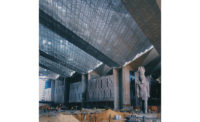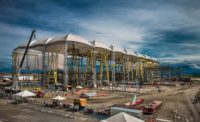By Michael J. Carragher, PE

Major shifts of people into cities is not new, but what makes urbanization different today for planners, engineers, architects, contractors, financiers and public administrators than in decades past is the magnitude and pace at which all of us now encounter disruptions.
Both positive and negative, they include never-before-seen population numbers, aging infrastructure, emerging technologies and climate change.
This pace of disruption will only increase for those of us known as city builders—professionals who develop innovative financing options, effective governance policies or unique plans and delivery methods to propel projects and investments that cities must have to strategically grow and strengthen their economic vitality.
We face some key challenges: How do we successfully address disruption and provide for continued growth and strategic densification of our cities? How do we reconnect with what is important to a thriving and healthy city—creating economically prosperous communities where people can live, work, and play and that are linked to boost mobility and access to opportunity?
The goal, of course, is to leverage the original formula for urban success: balance the need for economic vitality with an unwavering commitment to improved quality of life—progressing both simultaneously.
Sounds simple.
But that enhanced quality of life faces many new and significant disruptors as we look to build the future.
Staying Connected
Mobility to access a city’s economic opportunity WITHOUT a corresponding community for its people will fail every time. And, a community WITHOUT access to employment and economic opportunity will wither and die. We must progress strategic densification for growth while also enhancing what makes urban life so appealing to many.
While this goal may seem idyllic, it is not unattainable.
To strategically grow and build sustainable and economically thriving cities, we must systematically integrate community AND mobility, with a constant focus on stewardship to overcome many challenges we stand to encounter—now and in the future.
This integration is the problem-solving hallmark for us as effective city builders, and as an industry.
If we develop singular solutions, at a minimum, we will limit our potential and creativity, and end up with only partial resolutions that will miss the mark entirely.
Look at the building and layout of the interstate highway system. The solution enhanced mobility and got us from Point A to B more efficiently, but it did not always consider urban communities that were bulldozed or sliced in half.
It is when solutions integrate the elements of mobility AND community, while looking to the future with stewardship in mind, that we arrive at complete solutions.
What does this mean for us as city builders? What must we do to develop the next evolution of solutions?
Enduring Solutions
Major cities are comprised of a wide demographic base and strive to provide access to education, jobs, health care, and recreation. In those urban centers, traditional businesses and industries also seek to modernize, expand or create groundbreaking spinoffs—all accelerated by the push to make cities technologically accessible to everyone.
Boosting mobility of people and goods within and around a city is equally critical. Creating efficient movement spurs critical linkages, great ideas and growth in the economy.
The ideas of the last century need to be adapted to embrace a new mobility paradigm—not just with new infrastructure, but also by encompassing technology created that will provide seamless access to all components of a community.
Every integrated solution needs to enhance both community and mobility. A community’s quality of life significantly improves with access to multimodal mobility options, and mobility’s value increases when a community benefits and strengthens.
Once the two are integrated, we need to ensure they will endure for years to come. We became AEC sector professionals—city builders—because we believed we could help make the world a better place.
Our stewardship is a responsibility and commitment to plan and design for future generations, ensuring that solutions are sustainable, resilient to climate change and empowered with technological agility for added innovation yet unknown.
We need to embrace our knowledge and insights, as an industry, and use them to create, plan, design and build our cities to be ready for the future—not just for today’s challenges.
By creating integrated solutions that combine community, mobility and stewardship, we will avoid the temptation to incorporate siloed components into city planning.
We must raise the level of our thought process, seek out new ideas and evolve problem solving to a new level.
That challenge will also require us to embrace and capitalize on new financing approaches, business models and technologies to redefine the questions and generate those critically needed answers.
Michael J. Carragher is President and CEO of VHB, an engineering, science, planning, and design firm with 1,400 employees in 30 East Coast locations. He can be reached at mcarragher@vhb.com.





Post a comment to this article
Report Abusive Comment